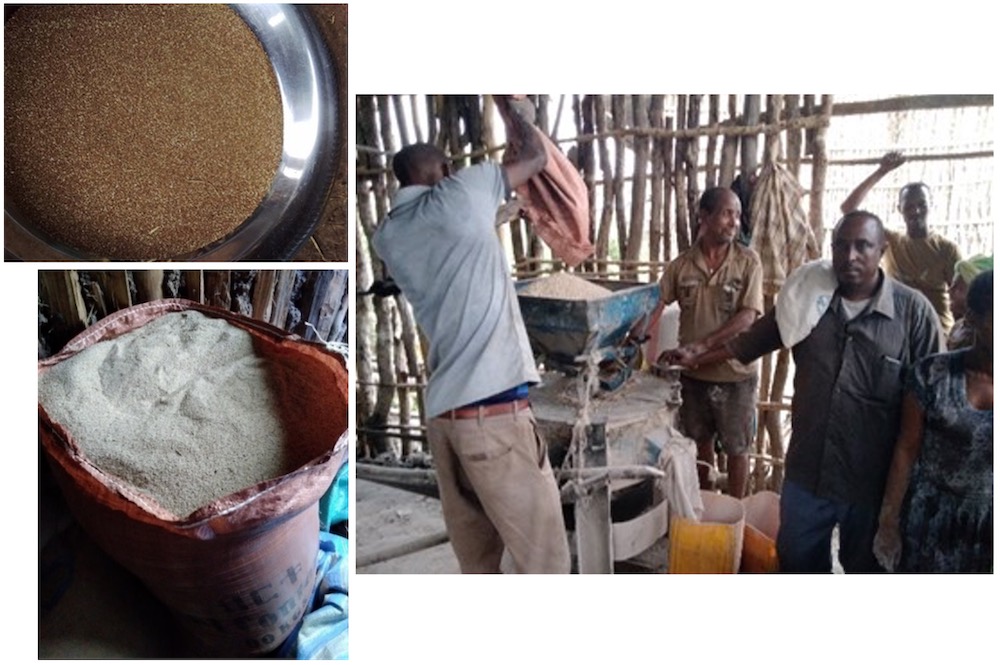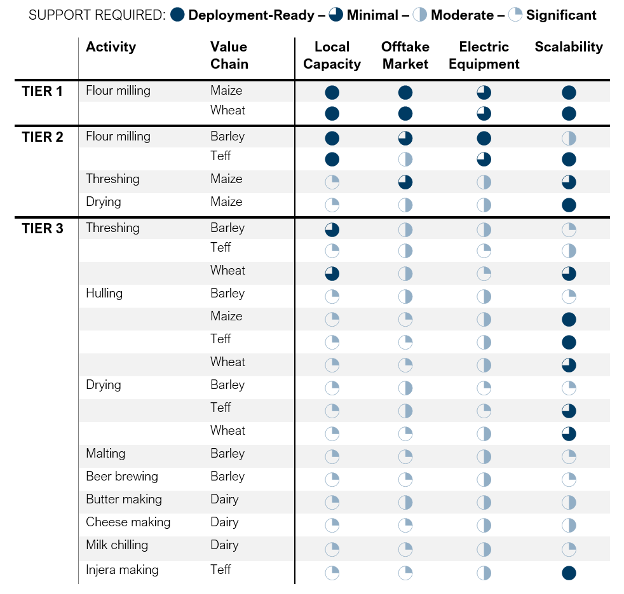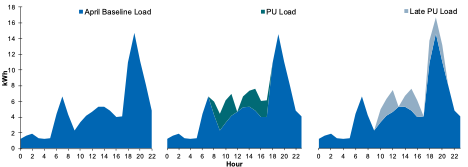
Electrifying Agriculture in Ethiopia
Empowering Livelihoods with Clean Energy
In Ethiopia, major institutions recognize that supporting productive uses of energy is key to achieve the national target of universal electrification. Both the Ministry of Water, Irrigation, and Energy (MOWIE) and the Ethiopian Electric Utility will leverage distributed energy resources and productive uses of energy to pursue universal electrification through the US$500 million Access to Distributed Electricity and Lighting in Ethiopia (ADELE) Project.
How should policymakers direct this funding? Development practitioners have limited clarity on the most suitable pathways for implementing rural electrification and interventions to support the adoption of productive uses throughout Ethiopia. But this alignment is critical to ensure that investments in rural electrification are optimized to support local development and agriculture sector growth in tandem.
RMI’s latest report, Productive Uses of Energy in Ethiopia, explores opportunities for electrifying agricultural processing and identifies business models and early strategies to test and scale activities with potential for electrification. We analyzed 22 post-harvest processing activities across teff, maize, wheat, barley, and dairy value chains.
Teff in grain form (top left), mechanized teff milling business (right), and processed teff flour (bottom left).
Using a multi-metric framework, we sorted through high potential activities depending on their appropriateness for electrification in the short term. Our evaluation was rooted in measuring the existing capability of processors, the strength of offtake markets for processed products, the suitability of processing activities for electrification, and scaling potential. By identifying the processing activities most viable for electrification today, we articulate a roadmap for prioritizing ADELE funding and developing a national productive use program. This includes field-testing with end-users, establishing the cross-sectoral partnerships to develop community projects, and identifying replication strategies for national scale-up.
The Potential of Grain Flour Milling
Grain flour milling shows strong potential for immediate electrification after field-testing. Processors already mill grains including maize, wheat, teff, and barley, mechanically in most Ethiopian rural communities. In addition, customers regularly pay for milling services, which indicates strong scaling potential and no requirement for market development. Furthermore, multi-crop milling equipment, which increases processors’ market size and reduces market risk from fluctuations in crop supply, strengthens the potential for electrifying milling.
Exhibit 1: Value chain analysis results ranked by deployment readiness and support required across evaluation criteria
A Win-Win for both Processors and Minigrid Operators
Electrifying grain milling can boost economic returns for processors. Mekuriaw Fetene Mogn, a small-scale processor in the unelectrified Gedam Got community from the Misrak Gojjam zone in Amhara region, processes teff, maize, and wheat for nearby customers using a diesel-powered grain mill. Mr. Mogn charges 100 Ethiopian birr (ETB) per quintal (around US$2.50), serves around 20 customers per day, and earns around 5,000 ETB (around US$125) in weekly revenues. He struggles to afford the high cost of diesel, which captures 60 percent of his earnings.
The energy cost savings of switching to electric mills are compelling. If Mr. Mogn switches to an electric mill, he can generate operational cost savings of 57 percent and double his profit margins with a 13 ETB/kWh (~US$0.33/kWh) electricity tariff. Sensitivity analysis suggests that as long as the electricity tariff remains below 27 ETB/kWh (US$0.68/kWh), switching to an electric mill is economically viable.
Additionally, the transition from a diesel-powered to an electric mill offers other benefits. It significantly reduces the burden, costs, and time of traveling to procure diesel (Mr. Mogn travels every other day to buy diesel in the nearest market). It also alleviates concerns of diesel price fluctuations that affect profitability.
RMI analysis highlights that Mr. Mogn can generate sufficient earnings to repay his capital investment in less than three years while generating a 66 percent return on investment in five years. Similar savings opportunities exist for many small-scale processors throughout rural communities in Ethiopia. Although results vary depending on volumes processed, our analysis shows that the typical agrarian community produces enough crop volumes to sustain three processors, even if less than 100 percent of the production is ultimately processed in the community.
Mekuriaw Fetene Mogn using his diesel-powered grain mill to process grains for a customer.
Furthermore, serving productive use loads—like electric milling—can improve minigrid economics by generating additional revenue for minigrid operators and increasing utilization of solar generation. Over 70 percent of the grain millers interviewed operate year-round during daytime hours, making them an attractive customer category for minigrid operators. Our analysis shows that loads from two electric grain flour mills (the median number of processors per community we observed in our field survey) can boost electricity sales by 13–22 percent and reduce the electricity tariff needed to recoup minigrid investment by 8–13 percent. As off-grid electrification rollout ramps up, additional field testing will help confirm these insights.
Exhibit 2: April load profiles of the community modeled with productive use loads at different hours
Processors Face Significant Challenges
Despite these early indications of a strong business case for electric equipment, most processors in rural communities remain unable to switch over to electric processing due to lack of access to reliable electricity service and affordable finance. “I definitely want to expand and enhance the milling business to make more money, even if it will require investment and more working time,” explained Mr. Mogn. “But having reliable and affordable energy sources is very challenging.” In fact, more than 80 percent of processors interviewed identified lack of access to electricity and finance as the most important barriers limiting their growth.
Balcha Ambisa with his stationary diesel-powered mechanical sheller in the Bildima Deru community of the Buno Bedele zone, Oromia.
To successfully electrify processing activities, rural development and electrification programs must address end-user needs like those expressed by Mr. Mogn. Processors need to understand the benefits and opportunities of switching to electric equipment and they need support to identify the right equipment and access finance. One approach to address these needs is through a fee-for-service business model, where a facilitator is introduced to connect processors to capacity building and financing. The facilitator would work in local communities to help with awareness raising, equipment selection, business planning, and loan development to equip processors with the knowledge and resources needed to switch over to electric equipment.
Supporting Local Development through a National Productive Use Program
The outlook for energy access in Ethiopia is promising. Government and development partners are increasing investment and widely recognize the importance of incorporating productive uses of energy in their planning. But linkages between agriculture, energy, and finance stakeholders are needed to de-silo investment decisions and synchronize rural development and electrification efforts to increase the impact on rural livelihoods.
A productive use program can guide policymakers, development partners, and practitioners to collaborate across sectors to field-test and vet opportunities and identify strategies to replicate successful projects throughout rural communities in Ethiopia. Over the next few months, the RMI team and its partner MOWIE will work together to develop a program that will pull in input from end-users and forge connections between and build consensus among agriculture, energy, and finance stakeholders.
In Ethiopia, the work continues to enable processors across rural communities—like Mr. Mogn—to power their livelihoods through clean energy systems. By identifying the productive use program needs and barriers, our study directly informs the ADELE Project on sustaining rural electrification efforts with robust demand stimulation planning and infrastructure. Currently 800 million people around the world have no electricity access. Productive uses of energy frameworks can empower livelihoods alongside efforts to provide power.
We thank the Ikea Foundation for supporting this work.
Download Productive Uses of Energy in Ethiopia.






